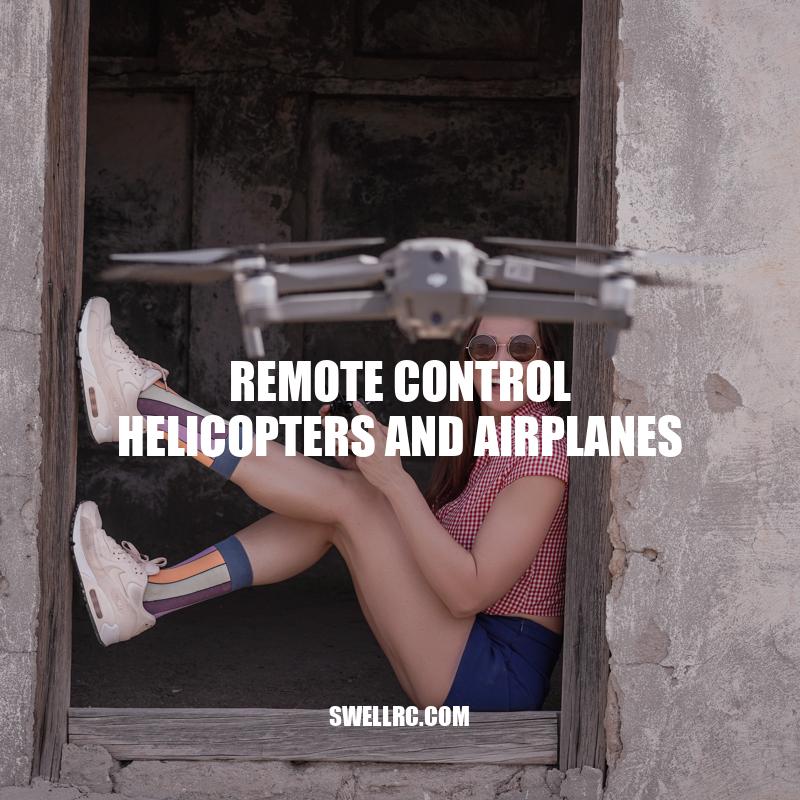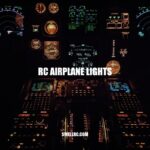Ultimate Guide to Remote Control Helicopters and Airplanes
Remote control helicopters and airplanes have become extremely popular in recent years. They are considered one of the most exciting toys for kids as well as adults, making them an extremely popular pastime. People have been using remote control aircraft for various scientific purposes too. These electronic toys are operated with a handheld remote control, and they can fly up, down, backward, and forward in any direction. They have become much more technically advanced in recent years, allowing for advanced features such as programmable flight paths, GPS navigation, and high-resolution cameras for taking aerial photographs. With the increasing popularity of remote control aircraft, there are many types, models, and designs available in the market, making it essential for prospective buyers to understand the various types available and their features. In this article, we will provide an overview of remote control helicopters and airplanes, their types, how to choose the right one, and safety and maintenance tips to keep them in top condition.
Types of Remote Control Helicopters and Airplanes
There are different types of remote control helicopters and airplanes that can suit a variety of individual needs and preferences. Below are the two major types of remote control helicopters:
- Single Rotor Remote Control Helicopters: These helicopters have one main rotor and a tail rotor that help maintain the stability and control the direction of the aircraft.
- Coaxial Rotor Remote Control Helicopters: These helicopters come with two sets of rotors that rotate in the opposite direction, eliminating the tail rotor. This feature provides users with greater control and flexibility when flying.
Single rotor remote control helicopters are relatively less expensive and have more intricate control compared to coaxial rotor remote control helicopters. However, the coaxial rotor helicopters are more stable and can be flown easily by beginners who may find single rotor helicopters difficult to control. Interestingly, some models like Blade Nano CP S2 are designed to offer the best flight experience for advanced pilots.
In addition to the types of rotor systems, remote control helicopters and airplanes can also be classified by their size, from micro to large, and by their power source, such as electric, gasoline, and nitro-powered models. Remote control helicopter enthusiasts can browse online stores or marketplaces like Amazon, eBay, Horizon Hobby or Visit Myquadcopter to find a variety of models and brands available in the market.
What are remote control helicopters called?
Remote control helicopters are also known as multirotor model helicopters. Multirotor designs have become popular in both RC hobby and unmanned aerial vehicle (UAV) research. These vehicles use an electronic control system and electronic sensors to stabilize the aircraft. For more information about remote control helicopters and related products, you can visit RC hobby websites or online stores.
Remote control airplanes come in different shapes and sizes, from tiny gliders to aviation wonders like Boeing 747s. Here are some types of remote control airplanes:
Glider Planes: Lightweight and meant to glide rather than powered flight. They are powered by electric or hand launch.
Park Flyers: Small, light, and designed to fly in limited areas like parks. They are powered by electricity.
Scale Planes: Realistic replicas of actual planes that can fly at scale speeds and altitudes. These planes are powered by electricity or gas.
Trainer Planes: Designed with a simpler flying structure that’s easier to learn on. They are powered by electricity or gas.
Warbird Planes: Replicas of planes used in military conflicts such as World War II. These planes are powered by electricity or gas.
Remote control airplanes are typically more expensive than helicopters, with some models costing several thousand dollars. Electric remote control airplanes are a popular choice because of their affordability, low noise level, and ease of use. On the other hand, gas-powered models are more complex to operate, make more noise, and are not environmentally friendly. Notably, some brands like SIG Mfg., E-flite, and Hobbico manufacture diverse models of remote control airplanes, each with unique features, designs, and performance.
Interestingly, the Guinness World Record for the largest remote control plane was set in 2016 by a group of Australian hobbyists. The plane, a B-52 Stratofortress model, had a wingspan of 28 feet and weighed 330 pounds.
Remote control airplanes and helicopters are fun to fly, but they should be registered with the Federal Aviation Administration (FAA) if used for recreational or hobby purposes. The registration, which costs $5, helps ensure the safe operation of remote control aircraft and compliance with state and local regulations.
What are remote controlled aircraft called?
Remote controlled aircraft are called unmanned aerial vehicles (UAVs), which can be either drones or RPVs. UAVs can fly for extended periods at a constant height and speed, making them useful in various domains of aviation.
How to Choose the Right Remote Control Helicopter or Airplane
Choosing the right remote control helicopter or airplane can be overwhelming for both beginners and experienced pilots. Here are some factors to consider before purchasing an RC aircraft:
- Experience level: Beginner pilots should start with a simpler model with lower speeds and simpler controls, while experienced pilots can opt for more advanced models.
- Flying location: Consider the location of flying – indoor or outdoor flying? Open and safe space or crowded areas?
- Power source: Decide between electric or gas-powered remote control aircraft. Electric aircraft are quieter and less expensive than gas aircraft.
- Budget: The price range for remote control helicopters and airplanes can be broad. Set a budget and select an aircraft model that suits your needs and resources.
- Types of flight: Consider what type of flight you would like to experience with your remote control helicopter or airplane. Some models are ideal for stunts while others are great for low and level flying.
Furthermore, there are various websites and online shops to help you find the perfect remote control helicopter or airplane for you. For example, Horizon Hobby is a popular online hobby store offering a range of remote control aircraft models and accessories for both beginners and experts. RC Planet is another reputable online RC shop that offers affordable remote control aircraft from popular brands like E-flite, Blade, and HobbyZone.
Choosing the right remote control helicopter or airplane largely depends on your preference and needs. It is essential to research and compare multiple models before making your final decision.
Which is better RC drone or helicopter?
According to popular opinion, drones are considered better than RC helicopters for aerial photography and filmography due to their stability and ease of control. Drones are widely used for both commercial and recreational purposes. For more information on drones, you can visit websites such as DJI.com or Amazon.com for a range of products.
Safety Tips for Flying Remote Control Helicopters and Airplanes
Flying remote control helicopters and airplanes can be fun and exciting, but it’s important to follow safety guidelines to prevent accidents or injuries. Here are some safety tips for flying remote control aircraft:
- Select the flying location with care: Choose an open and safe flying location, away from trees, buildings, and power lines to prevent the aircraft from colliding with obstacles.
- Check for local laws and regulations: Before flying, make sure to comply with local laws and regulations regarding remote control aircraft.
- Check weather conditions: Avoid flying in high winds or stormy weather conditions. This will prevent damage to your aircraft and reduce the risk of accidents.
- Perform a pre-flight check: Before every flight, inspect the aircraft and ensure it is in good working condition. Check for any visible damage and ensure all parts are secure.
- Fly with caution: Start flying with low speeds and in a low altitude. Gradually increase the speed and altitude once you are familiar with the controls and flying conditions.
- Keep the battery charged: A low battery life can cause the remote control aircraft to fall during the flight. Always keep an extra battery for backup, and ensure they are fully charged before flying.
In addition to following these safety tips, it is also important to invest in quality remote control helicopters and airplanes that come with features like auto-shutoff and durable designs. Some popular brands that offer safe and reliable remote control aircraft include DJI, Syma, and Blade. Furthermore, there are many online resources available to help pilots learn more about safe flying techniques and find answers to any questions or issues they may have.
How do you fly a remote control plane?
To fly a remote control plane, you need to follow the instructions provided by the manufacturer. Usually, you will need to charge the battery, turn on the remote control and plane, and adjust the trim settings. Once you’re ready, gradually throttle up the power and steer the plane using the control sticks. It takes practice and patience to become proficient at flying a remote control plane. Websites like RCGroups.com provide helpful tips and resources for beginners. You can also find various remote control planes and accessories on sites like HobbyKing.com.
Maintenance and Care for Remote Control Helicopters and Airplanes
Proper maintenance is essential to keep remote control helicopters and airplanes in excellent condition. Here are some tips for maintaining and caring for your remote control aircraft:
- Clean aircraft regularly: Dust and debris can accumulate inside the aircraft, causing damage to the motor and battery. Clean the aircraft regularly using a soft-bristled brush or dry cloth.
- Inspect the aircraft for damage: Check the aircraft for any visible damage before and after every flight. If any part is damaged, replace it immediately to prevent any mishap.
- Always follow manufacturer’s instructions: The manufacturer’s instructions will have information on how to maintain and care for the remote control aircraft.
- Store the aircraft properly: Store your remote control aircraft in a cool and dry place, away from direct sunlight, humidity and dust.
- Charge the battery safely: Always store the battery separately from the aircraft and at a moderate temperature. Overcharging or exposing the battery to extreme temperatures can cause it to malfunction and reduce its life.
- Keep spare parts: Always keep some spare parts like blades, gears, motors, etc., readily available as they can be difficult to find in physical shops.
Investing in quality remote control helicopters and airplanes is also key to ensuring their longevity. Popular brands like DJI, Syma, and Blade offer reliable and high-quality models that come with a warranty. In the event that you need to replace a part or purchase a new remote control aircraft, there are various online stores like Amazon, Banggood, and Hobbyking that offer a wide selection of remote control aircraft, parts, and accessories at affordable prices.
How does a remote control helicopter work?
A remote control helicopter works through the use of radio control. This involves the use of a handheld radio transmitter to send control signals to the helicopter. The transmitter generally has two sticks that are used to control the movement of the helicopter. On a 4-channel transmitter, there are different modes in which the control sticks can be set. Generally, the left stick controls pitch and yaw movements, while the right stick controls throttle and roll movements. If you want to know more about remote control helicopters, you can visit websites such as hobbytron.com or symatoys.com that offer a variety of models and information about the technology behind them.
Conclusion
In conclusion, remote control helicopters and airplanes are fascinating toys that provide hours of entertainment and educational opportunities for both kids and adults. From aerial photography to scientific research and pure enjoyment, remote control aircraft has proven to be a versatile and multifaceted hobby.
When buying a remote control aircraft, consider factors such as your skill level, desired features, budget, and brand reputation. It is also essential to follow proper safety precautions, maintain and care for your remote control aircraft well, and store it properly. By following these guidelines, you can safely and confidently enjoy your remote control aircraft and explore the boundless possibilities of controlled flight.



